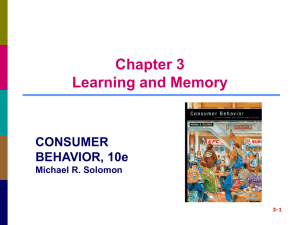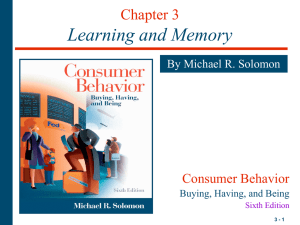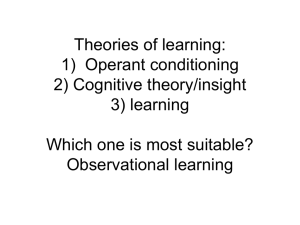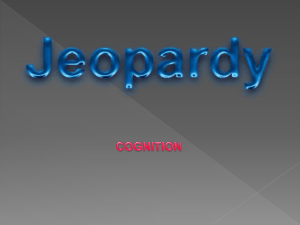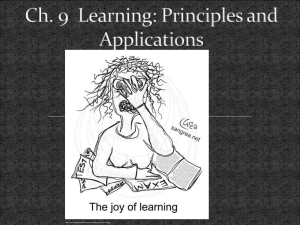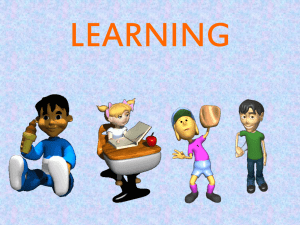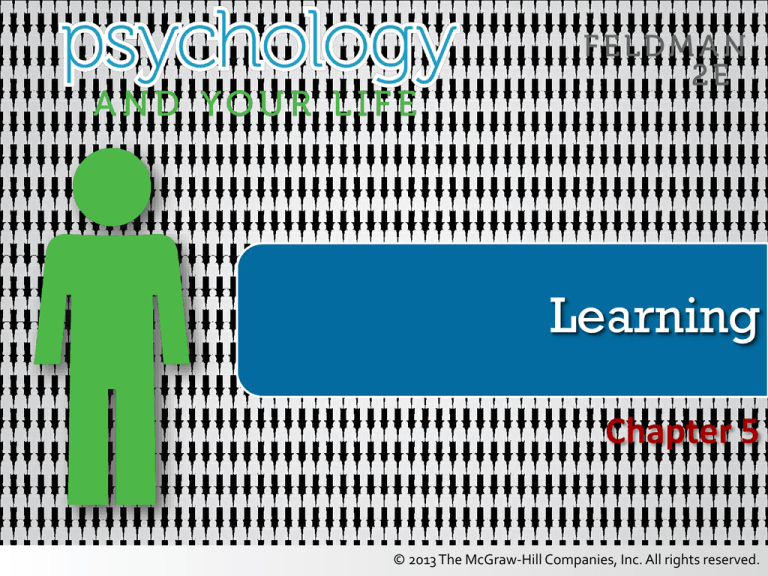
Learning
Chapter 5
© 2013 The McGraw-Hill Companies, Inc. All rights reserved.
Classical Conditioning
• Learning Outcomes
– Describe the basics of classical conditioning and
how they relate to learning
– Give examples of applying conditioning principles
to human behavior
– Explain extinction
– Discuss stimulus generalization and discrimination
2
© 2013 The McGraw-Hill Companies, Inc. All rights reserved.
The Basics of Classical Conditioning
• Learning: a relatively permanent change in
behavior brought about by experience
• Classical conditioning: a type of learning in
which a neutral stimulus comes to bring about
a response after it is paired with a stimulus
that naturally brings about that response
– Palov’s experiment
3
© 2013 The McGraw-Hill Companies, Inc. All rights reserved.
4
© 2013 The McGraw-Hill Companies, Inc. All rights reserved.
The Basics of Classical Conditioning
• Neutral stimulus: before conditioning, this
stimulus does not naturally bring about the
response of interest (bell)
• Unconditioned stimulus (UCS): stimulus that
naturally brings about a particular response,
without having been learned (meat)
5
© 2013 The McGraw-Hill Companies, Inc. All rights reserved.
The Basics of Classical Conditioning
• Unconditioned response (UCR): natural,
innate, reflexive response; unlearned
(salivation to meat)
• Conditioned stimulus (CS): once the neutral
stimulus, paired with a UCS to bring about a
response formerly caused by the UCS (bell)
• Conditioned response (CR): a response that,
after conditioning, follows a previously
neutral stimulus (salivation to the bell)
6
© 2013 The McGraw-Hill Companies, Inc. All rights reserved.
Conditioning and Human Behavior
• Human behavior is also learned through
classical conditioning, particularly emotional
responses, such as fear
– Watson & Rayner’s experiment to classically
condition Little Albert to show fear of a rat
•
•
•
•
Neutral stimulus = rat
UCS = loud noise
UCR = fear of the noise
CS = rat
• CR = fear of the rat
7
© 2013 The McGraw-Hill Companies, Inc. All rights reserved.
Extinction
• Extinction: a previously conditioned response
decreases in frequency and eventually
disappears
• Spontaneous recovery: the reemergence of
an extinguished conditioned response after a
period of rest and no further conditioning
8
© 2013 The McGraw-Hill Companies, Inc. All rights reserved.
Extinction
9
© 2013 The McGraw-Hill Companies, Inc. All rights reserved.
Generalization and Discrimination
• Stimulus generalization: a conditioned
response follows a stimulus that is similar to
the original conditioned stimulus; the greater
the similarity, the greater the likelihood for
generalization
• Stimulus discrimination: if two stimuli are
sufficiently different from each other that one
brings about the conditioned response but the
other does not
10
© 2013 The McGraw-Hill Companies, Inc. All rights reserved.
Operant Conditioning
• Learning Outcomes
–
–
–
–
–
11
Define the basics of operant conditioning
Explain reinforcers and punishment
Present the pros and cons of punishment
Discuss schedules of reinforcement
Explain the concept of shaping
© 2013 The McGraw-Hill Companies, Inc. All rights reserved.
The Basics of Operant Conditioning
• Operant conditioning: learning in which a
voluntary response is strengthened (more
likely to recur regularly) or weakened (less
likely to recur regularly), depending on its
favorable or unfavorable consequences
12
© 2013 The McGraw-Hill Companies, Inc. All rights reserved.
The Basics of Operant Conditioning
• Reinforcement: the process by which a
stimulus increases the probability that a
preceding behavior will be repeated
• Reinforcer: any stimulus that increases the
probability that a preceding behavior will
occur again
– Primary reinforcer
– Secondary reinforcer
13
© 2013 The McGraw-Hill Companies, Inc. All rights reserved.
Positive and Negative Reinforcers
• Positive reinforcer: a stimulus added to the
environment that brings about an increase in
a preceding response
• Negative reinforcer: an unpleasant stimulus
whose removal leads to an increase in a
preceding response
14
© 2013 The McGraw-Hill Companies, Inc. All rights reserved.
Punishment
• Punishment: a stimulus that decreases the
probability that a preceding behavior will
happen again
– Positive punishment: adding an unpleasant
stimulus to the environment
– Negative punishment: removing a pleasant
stimulus from the environment
15
© 2013 The McGraw-Hill Companies, Inc. All rights reserved.
Figure 2
16
© 2013 The McGraw-Hill Companies, Inc. All rights reserved.
The Pros and Cons of Punishment
• Punishment can be effective, but there are
also disadvantages
– Frequently ineffective if not delivered soon after
undesirable behavior
– Physical punishment can send message of
approval & even encouragement of physical
aggression in other situations
– Sometimes difficult for punisher to control the
degree/amount of physical punishment…“in the
heat of the moment”
17
© 2013 The McGraw-Hill Companies, Inc. All rights reserved.
Schedules of Reinforcement
• Schedules of reinforcement: different
patterns of frequency & timing of
reinforcement following desired behavior
– Continuous reinforcement schedule: reinforcing of a
behavior every time it occurs (learning occurs more
rapidly)
– Partial (intermittent) reinforcement schedule:
reinforcing of a behavior some (but not all) of the
time it occurs (behavior lasts longer after
reinforcement stops)
18
© 2013 The McGraw-Hill Companies, Inc. All rights reserved.
Schedules of Reinforcement
• Fixed-ratio schedule: reinforcement is given
only after a specific number of responses are
made (ex.: rat receives a food pellet every 10th
time it presses a lever)
• Variable-ratio schedule: reinforcement occurs
after a varying number of responses (ex.:
telephone salesperson’s job)
19
© 2013 The McGraw-Hill Companies, Inc. All rights reserved.
Shaping
• Shaping: the process of teaching a complex
behavior by rewarding closer and closer
approximations of the desired behavior
– First, reinforce any behavior that is remotely
similar to the desired behavior
– Then reinforce only responses that are closer to
the desired behavior
– Then reinforce only the desired behavior
20
© 2013 The McGraw-Hill Companies, Inc. All rights reserved.
21
© 2013 The McGraw-Hill Companies, Inc. All rights reserved.
Cognitive Approaches to Learning
• Learning Outcomes
– Explain latent learning and how it works in
humans
– Discuss the influence of observational learning in
acquiring skills
– Describe research findings about observational
learning and media violence
22
© 2013 The McGraw-Hill Companies, Inc. All rights reserved.
Cognitive Approaches to Learning
• Cognitive learning theory: focuses on the
thought processes (cognitions) that underlie
learning
23
© 2013 The McGraw-Hill Companies, Inc. All rights reserved.
Latent Learning
• Latent learning: Learning in which a new
behavior is acquired but is not demonstrated
until some incentive is provided for displaying
it
– Cognitive map: mental representations of spatial
locations and directions
24
© 2013 The McGraw-Hill Companies, Inc. All rights reserved.
Observational Learning
• Observational learning: learning by watching
the behavior of another person (model)
(Albert Bandura, the “social cognitive
approach”)
25
© 2013 The McGraw-Hill Companies, Inc. All rights reserved.
Violence in the Media
• Research supports the claim that watching high
levels of media violence makes viewers more
susceptible to acting aggressively
– One study found one-fourth of violent young male
offenders had attempted a media-inspired copycat
crime
26
© 2013 The McGraw-Hill Companies, Inc. All rights reserved.



